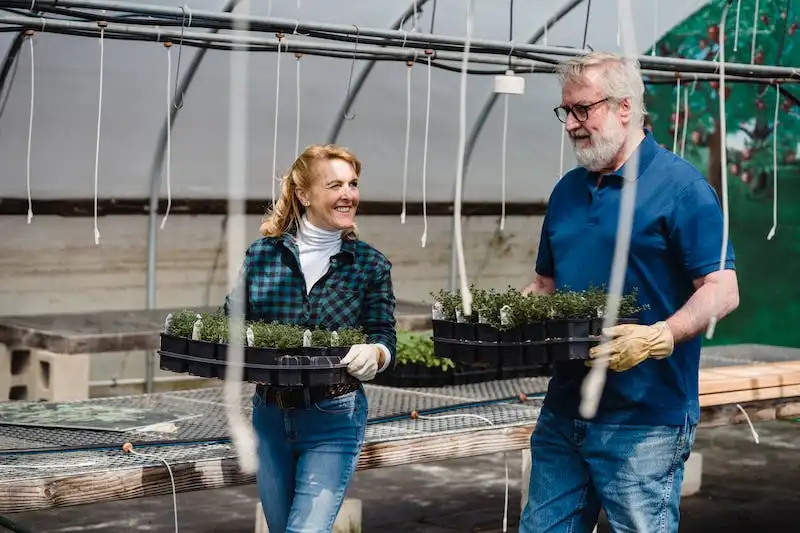Caladium bulbs contain everything needed to live through the winter and allow the plants to come back when it comes to warmer months. However, when the weather turns colder, it’s time to prepare these tropical perennials for winter. In this section of our gardening tips, we will provide you with all the information you need to know about overwintering caladium bulbs.
Caladium bulbs are traditionally used as annuals, but they can also be grown as perennials in USDA hardiness zones 10-11. If you choose to grow caladium bulbs as perennials, it’s important to follow the right steps to store them during the winter months. When digging up the bulbs, wait until the foliage starts turning long and pale, indicating that the plant is going into its dormant phase.
To store caladium bulbs during the winter, first dry them out for a few weeks. Then, pack them in coco coir or peat moss, making sure they are not touching each other. Store the bulbs in a cool, dry place where temperatures stay around 50-55°F (10-13°C). Thanks to this curing process, the bulbs can withstand cold temperatures and low humidity during the winter.
If you live in a colder climate and can’t keep the bulbs indoors, you can treat caladium bulbs as annuals. Dig them up before the first frost and store them in paper bags with a bit of dry peat moss or vermiculite. Keep the bags in a cool, dry place, such as a basement or garage. Just remember to check the bulbs occasionally and water them lightly if they become too dry.
When it comes to overwintering caladium bulbs, many gardeners have common questions. Here are some frequently asked questions about overwintering caladium bulbs:
Q: Can caladium bulbs be kept indoors during the winter?
A: Yes, caladium bulbs can be kept indoors during the winter. Just follow the same storing procedures mentioned earlier and keep them in a cool, dry place.
Q: How long can caladium bulbs be stored?
A: Caladium bulbs can be stored for several years if kept in the right conditions. However, the bulbs may lose some of their vigor after a few years.
Q: Do caladium bulbs need to be watered during the winter months?
A: Caladium bulbs are dormant during the winter months, so they only need to be watered lightly if they become too dry. Otherwise, it’s fine to let them rest without water.
By following these winter care tips, you can ensure that your caladium bulbs survive the winter and come back in full splendor next growing season. Whether you grow them as annuals or perennials, caladiums add beauty, color, and showmanship to any garden or indoor space. So, don’t let the colder months discourage you from keeping these lovely plants!
Caladium
Caladium is a genus of plants in the family Araceae. They are tuberous perennials that are native to tropical America.
Caladiums are known for their vibrant and colorful foliage, which comes in a variety of shapes and patterns. The most common species is Caladium bicolor, which is grown for its heart-shaped leaves that are often splashed with white, pink, or red.
These plants prefer well-drained soil and thrive in areas with temperatures between 65°F (18°C) and 80°F (27°C). They can be grown in both indoor and outdoor settings, making them a popular choice for garden enthusiasts.
When it comes to overwintering Caladium bulbs, it takes a little effort to ensure they survive the colder months. In zones 2-9, where temperatures drop below freezing, Caladium bulbs must be dug up and stored indoors during the winter.
The process of digging up Caladium bulbs involves cutting back the foliage and carefully lifting the bulb from the ground. It is important to handle the bulbs with care to avoid damaging them. Once dug up, the bulbs should be cured in a warm and dry location for a few days.
After curing, the bulbs can be stored in a cool and dry place, such as a basement or garage, until the following growing season. It is important to make sure the bulbs are kept away from heat sources, as excessive heat can cause them to dry out.
Before replanting the bulbs in the spring, they can be inspected for any signs of disease or damage. If a bulb appears soft or mushy, it should be discarded. Healthy bulbs can be placed in pots or planted directly in the soil, depending on your preference.
Caladium bulbs are also commonly used for propagation. Larger bulbs can be divided into smaller sections, each with at least one protruding bud. These smaller sections can then be planted to produce new Caladium plants.
Proper care during the growing season is essential for the health and longevity of Caladium plants. They should be watered regularly, but not overwatered, as Caladiums tend to prefer slightly moist soil. Fertilizing every 4-6 weeks with a balanced fertilizer can help promote growth and vibrant foliage.
Caladiums thrive in partial shade to full shade, making them an excellent choice for areas with limited sun exposure. They can also be grown indoors with bright, indirect lighting.
Whether you are bringing your Caladiums indoors for the winter or leaving them in the ground, proper care during dormancy is necessary. In colder areas, where the ground freezes, it is important to insulate the bulbs by adding a layer of mulch or straw over the planting area.
By following these instructions and providing the necessary care, your Caladiums will be ready to brighten up your garden or indoor space in the coming year.
Caladiums are a large genus of tropical perennial plants with over 1000 vibrant cultivars
Traditionally used in outdoor gardening in warmer climates, these broadleaf plants can bring a dramatic or subtle splash of color to any indoor space. While these plants require a little extra care when grown indoors, their lush showy growth makes it well worth the effort.
When it comes to growing caladiums indoors, there are a few key factors to consider:
1. Light: Caladiums prefer bright, indirect light. Place them near a window where they can receive filtered sunlight throughout the day.
2. Watering: Although caladiums like to be kept moist, be careful not to overwater them. Water thoroughly when the top inch of soil feels dry, and allow any excess water to drain away.
3. Temperature: Caladiums thrive in temperatures around 70-85°F (21-29°C). Avoid exposing them to cold drafts or temperatures below 60°F (15°C).
4. Humidity: These tropical plants appreciate high humidity levels. Consider using a humidifier or placing a tray with water nearby to increase humidity around the plants.
5. Pruning: If your caladiums start to become overgrown, you can prune them to maintain a more compact and attractive shape. Simply trim back any excessive foliage to promote healthy growth.
6. Resting period: Caladiums have a natural dormancy period, usually during the winter months. During this time, their foliage may die back, indicating that it’s time to rest. Reduce watering and move the plant to a slightly cooler location for a few months. You can also choose to dig up the tuberous roots and store them in a cool, dark place until spring.
By following these basic care guidelines, you can enjoy the vibrant, green foliage of these stunning plants throughout the year, both indoors and outdoors.
How to care for your Caladium
Caladiums are beautiful and vibrant plants that can bring a splash of color to any garden or indoor space. If you want to enjoy the full beauty of your Caladiums, it’s important to provide them with the right care. Here are some helpful instructions to keep your Caladiums healthy and thriving.
Planting and growing: Caladium bulbs can be planted in early spring, once the ground has warmed up and there is no longer any risk of frost. Choose a location that receives bright, indirect light for most of the day. Caladiums prefer well-draining soil with a pH around 5.5 to 6.5. Plant the bulbs about 2 inches deep, with the knobby side facing up.
Watering and humidity: Caladiums love water and thrive in humid conditions. Keep the soil consistently moist, but not soggy, throughout the growing season. If you’re growing Caladiums indoors, you can use a humidifier or place the pots on a tray filled with water and gravel to increase humidity around the plants.
Fertilizing: Feed your Caladiums with a balanced, slow-release fertilizer every 3-4 weeks during the growing season. This will help promote lush and vibrant foliage.
Pruning: To keep your Caladiums looking their best, prune any yellow or brown leaves as soon as you notice them. This will help prevent disease and keep the plant looking clean and healthy.
Overwintering: In colder climates (zones 9-11), Caladiums are not winter-hardy and need to be dug up and overwintered indoors. In late September or early October, carefully dig up the bulbs and let them air dry for a few days. Once they are dry, remove any soil and store the bulbs in a cool, dry place at a temperature of around 50-60°F (10-15°C). You can pack them in peat moss or vermiculite to help maintain their moisture levels.
Propagation: Caladiums can be propagated by dividing the bulbs. Once you dig up the bulbs for overwintering, you can carefully separate them into individual sections that contain at least one healthy bud. Plant these divisions in fresh soil and follow the planting instructions mentioned above.
FAQs:
Q: What’s the best light for Caladiums?
A: Caladiums prefer bright, indirect light. Direct sunlight can cause leaf burn and damage the foliage.
Q: How often should I water my Caladiums?
A: Keep the soil consistently moist, but not soggy. Water when the top inch of soil feels dry to the touch.
Q: Can Caladiums cause skin irritation?
A: Yes, the sap of Caladiums can cause skin irritation in some people. It’s recommended to wear gloves when handling the plants or their bulbs.
Q: What makes Caladiums such showy houseplants?
A: Caladiums are known for their dramatic and showy foliage, which comes in a wide range of colors, including shades of green, white, and vibrant reds. They add a touch of tropical flair to any indoor space.
Q: How long do Caladiums typically live?
A: Caladiums are considered tender perennials and can live for several years if provided with the right conditions and care.
By following these care instructions and meeting the specific needs of your Caladiums, you can enjoy their beautiful foliage and vibrant colors year after year.




